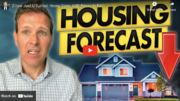Introduction:
The real estate market is a topic of great interest and concern for many people, whether you’re a prospective homebuyer, a current homeowner, or just someone curious about the state of the housing market. Zillow, one of the most prominent names in real estate data and analytics, has just made a significant U-turn in its predictions. In this blog post, we’ll delve into Zillow’s latest forecasts, explaining key financial terms along the way to make the information accessible to a wider audience.
Zillow’s Home Value Forecast:
Zillow’s recent predictions indicate a shift in the real estate landscape. They have revised their National Home Value Forecast downward due to consistently high mortgage rates and signs that the housing inventory shortage may be easing. The inventory crunch we witnessed earlier in the year, with a substantial increase in the number of homes for sale compared to the previous year, is now gradually narrowing. This increase in inventory is a crucial factor because it provides more options for homebuyers, thereby exerting downward pressure on home prices. This phenomenon illustrates a fundamental principle of economics: the balance between supply and demand.
Zillow’s Projections for Home Values:
Zillow now forecasts a 3% increase in home values for the current year, down from their earlier prediction of 3.3%. This forecast differs from other platforms like Redfin, which typically focus on median home prices. Redfin’s recent data suggests a 4% increase in median home prices over the last four weeks. However, the overall year-end forecast for home value changes is still uncertain, with estimates ranging from 0% to 5%.
Zillow’s Housing Market Forecast for Home Sales:
Zillow’s projections for home sales are equally intriguing. They anticipate 4.1 million existing home sales for this year, representing an 18% decrease from the previous year. This estimate, if realized, would mark the lowest level of home sales in 15 years, harkening back to the housing market crisis of 2008. In fact, if we see fewer than 4 million sales, it would be the lowest level since at least 1995.
Analyzing Zillow’s Sales Projections:
To contextualize these numbers, we need to understand the scale of the drop in home sales. Zillow’s forecast would require around 69,000 home sales in November and December combined, with an average of 34,500 per month. To put this in perspective, November and December of the previous year saw only 325,000 and 327,000 home sales, respectively. The current year’s forecast is significantly lower, indicating a substantial decrease in the demand for homes.
Factors Affecting Zillow’s Predictions:
Several factors contribute to Zillow’s predictions. They highlight the increase in new listings, which is a measure of the number of homes being put up for sale. While new listings remain historically low, they have been inching closer to pre-pandemic levels over the past few months. This trend implies more options for potential buyers, which, as mentioned earlier, tends to drive prices down due to reduced competition.
The Role of Mortgage Rates:
Another factor affecting Zillow’s predictions is mortgage rates, which have remained elevated. As of November 27th, the average 30-year fixed mortgage rate stood at 7.35%. While this rate is lower than it was a month ago (8.03%), it’s significantly higher than the rates of the past two decades. Elevated mortgage rates can deter potential buyers and contribute to a slowdown in the housing market.
The Balance of Supply and Demand:
In conclusion, the future of the US housing market hinges on the balance between supply and demand. Currently, low housing inventory and affordability issues are reducing demand, while a modest increase in new listings is addressing supply constraints. The potential for a surge in listings, and subsequently a decline in prices, may depend on factors like economic uncertainty and homeowners’ financial situations.
In this dynamic real estate environment, it’s essential for both buyers and sellers to stay informed and adapt to changing market conditions. As we move forward, it will be fascinating to see how these predictions align with the actual developments in the real estate market.







